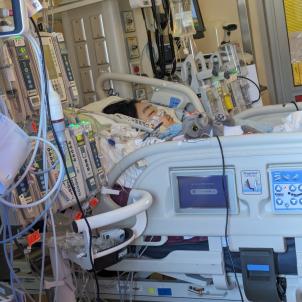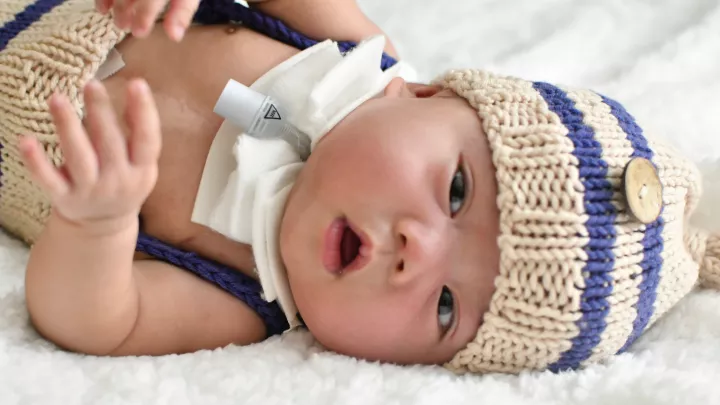
A Surgical Breakthrough at CHLA Frees Teen From Chronic Pancreatitis
This next anecdote isn’t likely to be passed around at future holiday dinner tables, but it will always provide Elliott’s father with a point of reference for the first eruption of his son’s pancreatitis.
“I still remember what meal he had,” Joseph says. “He had a cheeseburger and then got sick that night, and then didn't eat or drink for three or four days.”
Thinking more on it, Joseph sets the timeline back further. He recalls earlier indications of a problem. “Far back as third grade, he would have really bad stomach cramping.”
So bad that Elliott would end up repeatedly in the nearest emergency room, but each time was sent home on the conclusion that he was constipated, and with the instruction to drink more water and eat more fiber.
The burger incident prompted a blood test, which revealed an exorbitant level of a pancreatic enzyme called lipase. That produced a firm diagnosis—and reassurance from a gastroenterologist that unfortunately would be disproven: “The nice thing is it's acute pancreatitis. He won't have it ever again.”
From acute to chronic

One episode of acute pancreatitis—short-lived inflammation of the pancreas—turned into several. Severe abdominal pain, nausea and vomiting persisted, and Elliott’s diagnosis was updated to chronic pancreatitis. He came to see Children’s Hospital Los Angeles gastroenterologist Yuhua Zheng, MD, MS, Director of CHLA’s Pancreas Program.
With chronic pancreatitis, Dr. Zheng explains, enzymes secreted by the pancreas and meant to help with digesting food after reaching the small intestine become active within the pancreas itself. Put plainly, the pancreas starts to consume itself.
“It's like pouring sulfuric acid on it,” Dr. Zheng says.
Elliott’s pain was excruciating, and he would make hospital visits at least monthly, where doctors would hydrate him and tamp down the pain and inflammation with medication. But even the effort to hydrate him would aggravate his insides.
“He would have a sip of water and then vomit,” Joseph says.
Interventions were made, including a cystogastrostomy, a procedure to drain small sacs of fluid called pseudocysts that form outside the pancreas. Another option tried was endoscopic retrograde cholangiopancreatography (ERCP), in which doctors explore the patient’s gastrointestinal tract with an endoscope, looking to clear away blockages in the ducts that carry digestive juices away from the pancreas and toward the stomach.
But ERCP can only be performed so many times. Three is typically the limit; Elliott had four.
“If a patient requires more than three, the pancreatitis is still advancing and ERCP is not the best option anymore,” Dr. Zheng says. “Every time you have pain, I can give you supportive care, but none of this is curative."
Taking the last resort

One option out there was curative, but it was extreme, considered a last resort, and so rarely performed that it had never been done before on a pediatric patient in Southern California: a surgical removal of the pancreas known as TPIAT.
“A patient is a candidate only when the pain is constant and it’s affecting their quality of life,” Dr. Zheng says.
TPIAT can best be understood by unraveling the acronym. TP, or total pancreatectomy, is the removal of the diseased pancreas, which then is sent to a specialized lab in preparation for IAT—islet auto-transplantation—the extraction of insulin-producing islet cells from the pancreas, which are then returned to the operating room and transfused into the patient’s liver.
The hope is that the islet cells can continue to supply the body with insulin, the hormone that regulates a person’s blood sugar, from inside its new residence—the liver. With the decayed pancreas removed, the patient is free of pain, gets off opioids, and can experience a renewed quality of life.
However, a common consequence of the procedure is diabetes. If harvesting the islet cells doesn’t salvage enough of them to produce all the insulin the body needs, the patient requires the support of an insulin pump.
Dr. Zheng thought that would likely be the result for Elliott. His pancreas had gotten too small, chewed up by pancreatitis, so the islet cell yield figured to be low. Dr. Zheng set his chances of not being insulin dependent at 15%.
Elliott, now 13, and his family welcomed those odds. After multiple ERCPs, an ongoing reliance on opioids for pain management and nonstop trips to the hospital, they would gladly exchange all that for managing diabetes. They decided if genetic testing showed Elliott’s malfunctioning pancreas was in his genes—as it usually is, Dr. Zheng says, in a case of relentless pancreatitis—they would push for TPIAT.
“My wife and I looked at how much weight he had lost, how much struggle he had gone through,” Joseph says. “We point-blank asked the doctor, ‘If he tests positive, when can we move forward with the procedure?’”
Preparing to launch

Genetic testing found that Elliott had the PRSS1 mutation, the gene tied to both acute pancreatitis and chronic pancreatitis, giving Dr. Zheng the opportunity to go forward with the hospital’s first TPIAT patient—and the first in all of Southern California.
The problem was that she didn’t yet have a TPIAT program established to make the procedure available. It had been a slow-moving aim of hers since she started CHLA’s Pancreas Program in 2017, but because the volume of patients with intractable pancreatitis was so small, other priorities were always supported first.
Now Dr. Zheng had a patient in need and a willing family, and she began working fiercely to get the pieces and people in place, further motivated by the occasional polite nudge from an antsy Joseph, who would email her for status updates.
“At the very beginning I was thinking, ‘I can do it!’” she says.
She was buoyed by her supreme confidence in the surgeon who would perform the procedure, Yuri Genyk, MD, Division Chief of Abdominal Organ Transplantation—“one of the best in the nation,” Dr. Zheng says. “But in the middle I got very anxious. There were so many things I needed to do.”
The largest of them was recruiting her colleagues. She needed the involvement and expertise of numerous specialties across the hospital. She lists gastroenterology, endocrinology, infectious diseases, anesthesia, pain management, and several others. Once she had a team, Dr. Zheng had the next phase to consume her: “I realized I needed to train everybody.”
Then came the procedure itself—a multistep, multi-facility operation that would run from morning till night and require precise, coordinated timing the whole way through. Elliott’s pancreas would be removed and then transported 25 miles east, to a lab at the City of Hope in Duarte, California, which had partnered with CHLA on the procedure. There, the islet cells would be extracted, driven back to Children’s Hospital, and infused into Elliott’s liver through the portal vein.
Dr. Zheng had the team perform two practice runs before surgery day, April 9. The smallest details were accounted for, down to using small, cooked potatoes as pretend islet cells.
“Every single step you have to think about,” Dr. Zheng says. “Who will package the pancreas, who will deliver it from the OR to the front desk, and who will pick it up? And then the courier driver—where can he park?”
In addition to overseeing the entire operation, she was assigned a role in it. Dr. Genyk asked Dr. Zheng to manipulate the bag of islet cells as the cells were being infused into Elliott’s portal vein, so that they wouldn’t cluster and create a blockage in the vein.
The surgery took 14 hours and was executed without flaw. Elliott’s recovery sailed above expectations. Within a week, he was off all pain medications. “Not even Tylenol,” Dr. Zheng says. “That is like, wow.”

‘We proved we can do it’
The job is hardly over, though. Post-surgery, the fragility of the transplanted islet cells is the main concern, forcing Elliott’s blood sugar to stay within a narrow range—between 80 and 120 milligrams/deciliter.
“Cannot be high, cannot be low,” Dr. Zheng says. “Otherwise the islet cells are not going to survive.”
A continuous glucose monitor is affixed to the back of Elliott’s arm. If his blood sugar gets outside the 80-120 range, the device signals an insulin pump attached at his waistband to adjust the level of insulin it’s pushing into his body accordingly.
Dr. Zheng says it takes a year before she can determine how many of the transplanted islet cells survived the procedure, embedded in the liver, and are making insulin. That number will determine how much help from an insulin pump Elliott will need.
“His chance for being insulin-free is low,” she says, “but even if a partial amount of islet cells survive, that is still very good. That means his insulin requirement will be minimal. Elliott understood he may be insulin dependent for the rest of his life. He said, ‘I’ll take that. I'm OK.’ He doesn't have pain. And that's the most important thing.”
Elliott is now designated as having type 3c diabetes—a category for people whose disease is the result of a damaged pancreas. Still, his father says it’s a far better outcome than the endless pain and disruption Elliott was experiencing.
“We'd much rather choose what we have right now,” Joseph says. “He's looking forward to hanging out again with his friends without worrying, ‘If I eat this, will it cause a flare-up? If I work out too much or walk too much, will it cause a flare-up?’ He likes not having to worry about anything other than his blood glucose levels.”
Dr. Zheng says there was a time she doubted she would ever get Elliott to this point, as she assembled the program while managing conflicts that naturally arise with any undertaking of such scope. She credits Rohit Kohli, MBBS, MS, Chief of Gastroenterology, Hepatology and Nutrition, for anchoring her.
“Whenever I felt, ‘Am I doing the right thing? Should I continue?’ He’d say, ‘It's normal. It’s not something that only happens to you. This is a new thing. We deal with the problem and move on.’ And toward the end, it all worked out.”
Now she has a second patient with chronic pancreatitis scheduled for TPIAT this summer.
“We proved we can do it,” she says. “I can help my patients, advocate for my patients. That is huge for me. Now I can help them.”


